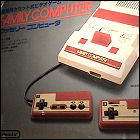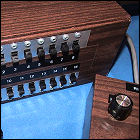Hiroshi Yamauchi, Nintendo president, dies
 The president of Nintendo through the latter half of the 20th century, Hiroshi Yamauchi, dies at the age of 85. Having dropped out of college to assume control of Nintendo from his ailiing grandfather in 1949, Yamauchi transformed the company from a maker of playing cards into a power player in the electronic game market, even though Nintendo’s first video game product was a licensed version of the American-made Magnavox Odyssey. Twice, Yamauchi boldly decided to break into the American video game market with no guarantee of success: once with the arcade game Donkey Kong, and again with the launch of the Nintendo Entertainment System, even after a Stateside licensing deal with Atari fell through at the last minute, depriving the NES of Atari’s existing marketing and distribution channels.
The president of Nintendo through the latter half of the 20th century, Hiroshi Yamauchi, dies at the age of 85. Having dropped out of college to assume control of Nintendo from his ailiing grandfather in 1949, Yamauchi transformed the company from a maker of playing cards into a power player in the electronic game market, even though Nintendo’s first video game product was a licensed version of the American-made Magnavox Odyssey. Twice, Yamauchi boldly decided to break into the American video game market with no guarantee of success: once with the arcade game Donkey Kong, and again with the launch of the Nintendo Entertainment System, even after a Stateside licensing deal with Atari fell through at the last minute, depriving the NES of Atari’s existing marketing and distribution channels.
White House honors Odyssey inventor
 Ralph Baer, the inventor of home video games, receives the National Medal of Technology from President George W. Bush. While working for defense contractor Sanders & Associates in the 1960s, Baer pioneered the concept of interactive television programming, eventually gathering a hand-picked team to create a prototype called the Brown Box. Baer and his employer licensed the technology to Magnavox, which repackaged it and marketed it as the world’s first home video game console, the Odyssey. Baer also created other key video game innovations, such as the first light gun.
Ralph Baer, the inventor of home video games, receives the National Medal of Technology from President George W. Bush. While working for defense contractor Sanders & Associates in the 1960s, Baer pioneered the concept of interactive television programming, eventually gathering a hand-picked team to create a prototype called the Brown Box. Baer and his employer licensed the technology to Magnavox, which repackaged it and marketed it as the world’s first home video game console, the Odyssey. Baer also created other key video game innovations, such as the first light gun.
The Brown Box
 At Sanders Associates, Ralph Baer completes the sixth iteration of his recently-patented Television Gaming & Training Apparatus, now covered in brown woodgrain and called “The Brown Box.” Utilizing logic circuits and spot generators rather than a computer chip, the Brown Box is capable of playing video ping pong and other simple games. This is the prototype of the first mass-marketed home video game system. Sanders begins courting prospective licensees, including RCA, Zenith, General Electric, Motorola and Magnavox; companies already manufacturing television sets will be the corporate entites most likely to show an interest. RCA declines, but one of its executives, having seen the Brown Box demonstrated, later defects to Magnavox, which eventually licenses the Brown Box technology from Sanders. The result will be the Magnavox Odyssey, the first-ever home video game console.
At Sanders Associates, Ralph Baer completes the sixth iteration of his recently-patented Television Gaming & Training Apparatus, now covered in brown woodgrain and called “The Brown Box.” Utilizing logic circuits and spot generators rather than a computer chip, the Brown Box is capable of playing video ping pong and other simple games. This is the prototype of the first mass-marketed home video game system. Sanders begins courting prospective licensees, including RCA, Zenith, General Electric, Motorola and Magnavox; companies already manufacturing television sets will be the corporate entites most likely to show an interest. RCA declines, but one of its executives, having seen the Brown Box demonstrated, later defects to Magnavox, which eventually licenses the Brown Box technology from Sanders. The result will be the Magnavox Odyssey, the first-ever home video game console.
The ‘480 Patent
 Ralph Baer files the first patent for his Television Gaming & Training Apparatus, United States patent #3,728,480. The patent is assigned to Baer’s employer, government contractor Sanders Associates, and is the first patent filed for the design of a video game. Though Baer will eventually build, and sell the design for, the first home video game, the real reward to be reaped from this patent will be licensing: every company manufacturing a video game console will have to pay Sanders and Baer for the privelege of expanding upon this basic patent, and it stands up in numerous court cases well into the 1980s as the “pioneer patent of the video game industry.”
Ralph Baer files the first patent for his Television Gaming & Training Apparatus, United States patent #3,728,480. The patent is assigned to Baer’s employer, government contractor Sanders Associates, and is the first patent filed for the design of a video game. Though Baer will eventually build, and sell the design for, the first home video game, the real reward to be reaped from this patent will be licensing: every company manufacturing a video game console will have to pay Sanders and Baer for the privelege of expanding upon this basic patent, and it stands up in numerous court cases well into the 1980s as the “pioneer patent of the video game industry.”
The day video games were born
 In a hand-written design document, Ralph Baer, an engineer working for defense contractor Sanders Associates, sketches out his ideas for a device he calls a TV Gaming Display. The design proposal lays out a concept to take television from being a passive form of entertainment to an interactive one in which two players can manipulate simple on-screen displays to play various games. Management at Sanders recognizes the potential of the invention, and Baer proceeds with development of the first video game prototypes, one of which becomes the basis for the first home video game console, the Magnavox Odyssey, six years later.
In a hand-written design document, Ralph Baer, an engineer working for defense contractor Sanders Associates, sketches out his ideas for a device he calls a TV Gaming Display. The design proposal lays out a concept to take television from being a passive form of entertainment to an interactive one in which two players can manipulate simple on-screen displays to play various games. Management at Sanders recognizes the potential of the invention, and Baer proceeds with development of the first video game prototypes, one of which becomes the basis for the first home video game console, the Magnavox Odyssey, six years later.